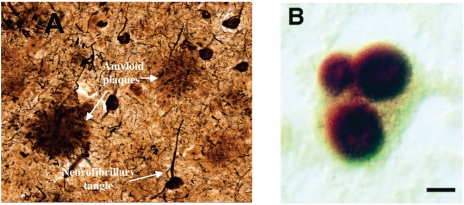Figure 1.
Pathological hallmarks of Alzheimer’s and Parkinson’s diseases. (A) Tangles and plaques in Alzheimer’s disease. Neurofibrillary tangles are intraneuronal and consist of paired helical filaments, the subunit of which is a microtubule-associated protein called tau that has been phosphorylated at multiple sites (dark staining structures). Amyloid plaques are extracellular and are largely composed of a ~4-kDa protein called the amyloid β-protein (Aβ) (round diffuse structures). See Acknowledgements for source information on panel A. (B) Lewy bodies in Parkinson’s disease. Nerve cell with 3 Lewy bodies that are double-stained for α-synuclein (brown) and ubiquitin (blue). Where only α-synuclein is stained, the color appears as pale reddish-brown, but where ubiquitin also is stained, the superposition of color gives a dark black and brown appearance. The blue staining is not seen on its own, because all the ubiquitin-immunoreactive structures are also positive for α-synuclein. The halo of each Lewy body is strongly immunoreactive for ubiquitin, whereas both the core and the halo of each Lewy body are immunoreactive for α-synuclein. Bar, 10 μm. Panel B has been reproduced from Figure 3 of Spillantini et al. (96), © 1993–2005 by the National Academy of Sciences of the USA, all rights reserved.

